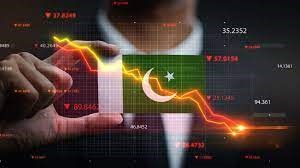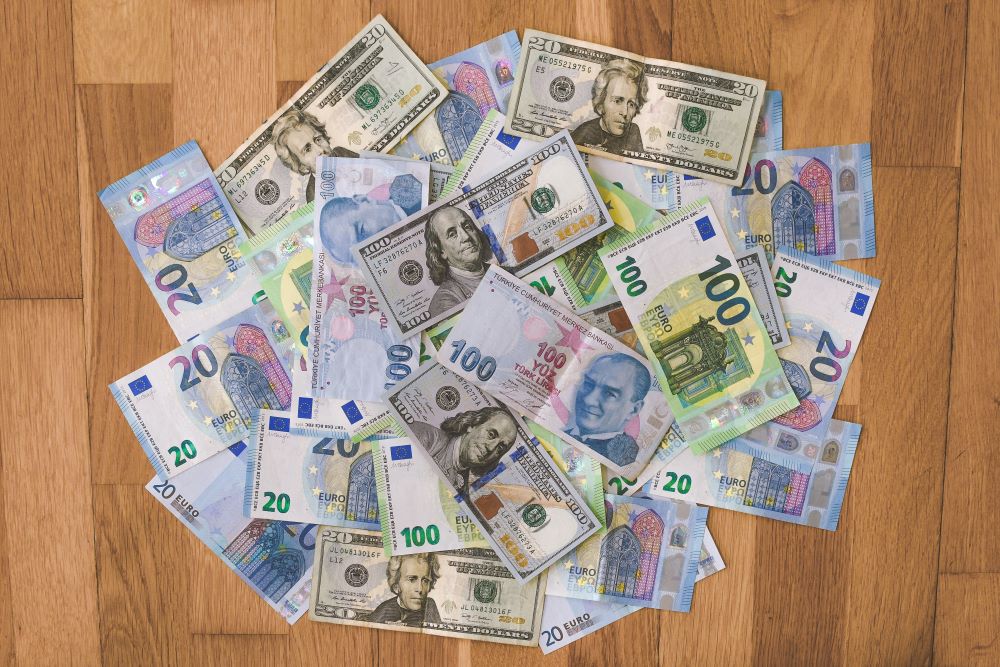Post the difficult pandemic years of 2020 and 2021 the world was witnessing a nascent recovery
starting in 2022 but the subsequent Russian-Ukrainian conflict started in February 2022 has led to huge
global consequences. Soaring food and energy prices and skyrocketing inflation has hit the entire world
and high levels of debt and tightening global financial conditions have made it even more difficult for
governments to manage their economies.
Amongst many others, our Asian neighbours like Sri Lanka and Pakistan have gotten into economic
distress since then and have again approached the International Monetary Fund (IMF) to bail them
out.
Let’s deep dive into the details.
Sri Lanka

Grappling with soaring inflation and food, medicines, and fuel shortages, Sri Lanka’s foreign exchange
reserves fell to a record low of below USD 50 mn in May 2022 not enough to cover even 1 month’s
imports leading to its default on its foreign borrowings for the first time in its history.
– The International Monetary Fund (IMF) had tentatively offered Sri Lanka a USD 2.9bn loan to help the
country recover from its economic crisis. The funding is meant to provide some breathing space for Sri
Lanka, which is scrambling to restructure nearly USD 30bn in debt to creditors including China, India
and a string of international banks.
– However, in return, the Sri Lankan authorities will have to commit to a four-year programme involving –
a) significant tax changes including broadening the scope of corporate income tax and VAT
b) making personal income taxes more progressive
c) increase electricity prices
– However, the country still needs to strike deals with international banks and asset managers that hold
the bulk of its USD 19bn in sovereign bonds, which are now in default.
– Japan has offered to lead talks with Sri Lanka’s other main creditors, including India and China.
– Sri Lanka requires the backing of China and India – its biggest bilateral lenders – to reach a final
agreement with the IMF on the USD 2.9 billion loan that is essential to help the country emerge from
its worst financial crisis in seven decades.
– India has recently conveyed to the IMF that it strongly supports Sri Lanka’s debt restructuring plan so
that the loan process can go forward.
As mentioned earlier the Pakistani economy also is in dire straits –

- High inflation and food shortages: The floods in Pakistan in 2022 cost the nation an
unprecedented USD 3 bn in damages, destroyed essential infrastructure, uprooted 8 million people,
and reduced domestic output and shortages that resulted in the cost of perishable foods and
essential items rising to uncomfortable proportions impacting the life of the common man. Inflation
currently stands at a record 28%. - High Indebtedness: Pakistan has long struggled with its heavy external borrowings from the IMF
and other institutions and countries. Its total external debt is around USD 100 bn of which
approximately 30% is to China and around USD 22 bn is repayable within 12 months. - Foreign Exchange Reserves: From a high of USD 22 bn at the beginning of 2022 it currently stands
at around USD 3 bn not enough to cover even a month’s imports. This has been primarily on
account of pay back of prior foreign debt and fall in exports and forex remittances to the country
and a sharp rise in gold imports.
Given the dire situation, the country has again approached the IMF to bail them out with an assistance to the tune of USD 1.1 bn to avoid immediate default and a further tranche of USD 6.5 bn.
The conditions set by the IMF are –
1) Increase income tax rates and indirect taxes such as Sales and Import taxes.
2) End exemptions for the export sector.
3) Raise low energy prices both on fuel as well as power tariffs.
4) Reduce subsidies that were benefitting those apart from the poor.
So what is the IMF and what exactly is its role? What are the contours of the assistance that it has
provided in the past typically? Have they been effective in getting countries out of trouble? What has
been the impact of the conditions imposed by it on the countries?
When and why was the IMF set up?
In 1944, 44 allied nations convened at the Bretton Woods Conference to establish a post-World War
financial order that would facilitate economic cooperation and prevent the reasons that brought
about the Great Depression of the 1930’s. The new regime was intended to foster sustainable
economic growth, promote higher standards of living and reduce poverty. The historic accord
founded the twin institutions of the World Bank and the International Monetary Fund (IMF).
Unlike the World Bank, which was designed as a lending institution focused on longer-term
development and social projects in countries, the IMF was conceived as a watchdog of the
monetary and exchange rate policies vital to the smooth functioning of global financial markets.
Called the world’s “financial crisis fighter,” the IMF has been relied on by member countries to deal
with crippling sovereign (government) debt and prevent a contagion from spreading through the
global financial system.
How the IMF does this?
The IMF permits its member countries to access a common pool of funds that represents the financial
commitment or quota contributed by each nation, relative to its size.
In theory, members with balance-of-payments trouble seek recourse with the IMF to buy time to
rectify their economic policies and restore economic growth. Apart from providing financial policy
and macroeconomic advice, the fund gives loans to member countries that are struggling to meet
their international debt obligations. Loans, or bailouts, are provided in return for implementing
specific IMF conditions designed to put government finances on a sustainable footing, manage their
foreign debt better and restore growth.
Known as “structural adjustment,” these policies typically include
– balancing the budget by removing state subsidies, increasing taxes
– privatizing state enterprises
– liberalizing trade and currency policy
– removing barriers to foreign investment and capital flows.
Historically, much of the fund’s work has been done in developing countries, including interventions
in Thailand, S.Korea, Brazil, Indonesia, and India itself in 1991. However, the 2008 global financial
crisis and subsequent European debt crisis required major bailouts in advanced eurozone economies,
such as Greece, Iceland, Ireland, and Portugal, for the first time.
The Mixed Bag
The IMF has drawn vocal criticism over the years for the mixed results witnessed in the recipient
countries. Critics point out that the conditions imposed by it for its lending— fiscal austerity, high
interest rates, trade liberalization, privatization, and open capital markets, have often been
counterproductive for many countries and devastating for local populations in many recipient
countries while showing reasonably good results in some others.
Let us look at the various crisis that the IMF has handled since the late 90s.
Asian financial crisis (1997-98) – The financial crisis started in Thailand in 1997 and gripped
much of East and Southeast Asia. In the latter part of 1997 and early 1998, the IMF provided USD 36 bn
to support reform programs in the three worst-hit countries of Indonesia, S.Korea, and Thailand. The IMF
gave this financial support as part of international support packages totalling almost USD 100 bn.
In an analysis of the IMF conditionalities imposed on the said countries’ reduced budget (fiscal)
expenditure and tighter monetary policy leading to high-interest rates and banking and corporate
reforms have all taken a toll on the recipient countries by worsening the recession situation and caused
credit crunch for the affected banks and firms. Also, critics argued that banking reforms should have been
implemented after, not during the crisis.For instance, the closure of weak banks in Indonesia during the crisis led to further bank runs.
At first, the IMF maintained that all policies they had implemented were basically right. But after several
months, crisis-hit countries were permitted to take more expansionary fiscal and monetary policies.
In 2003, the Independent Evaluation Office of the IMF issued a report which recognized that the Fund&policy
response of design and implementation in Indonesia, Korea, and Brazil was inappropriate.
Basically the conventional approach of tighter fiscal and/or monetary policies, and asking for immediate
structural reforms when a crisis broke out were the moot points of these bailouts by the IMF.
Global Financial Crisis (2007-08)
In 2008 a housing loan crisis originated in the US and turned into a full-blown financial crisis throughout
the world. The IMF lent almost USD 400 bn to 38 countries to help them deal with the crisis that
unravelled. For the first time, the IMF was called in to bailout advanced countries like Greece, Portugal,
Spain and others.
Greece’s economic problems which started in 2008-09 worsened after accepting the IMF’s loan
conditions in 2015. The austerity measures specified by the IMF included raising taxes, lowering
pensions and other spending, and privatising industries. However, later Greece saw the IMF soften
its stance on austerity as being counterproductive and the unsustainability of its high debt, putting it
at odds with the rest of the institutions that had also given loans.
The IMF’s remedy for Greece and Portugal during the Eurozone crisis has been straight out of the
structural adjustment playbook –
– reduce public spending
– cut salaries and benefits
– insist that state-owned enterprises return to the private sector
– reduce minimum wages, and restrict unionisation
While the final verdict on the European Bailout programs is still out, critics point to the deep
recessions and years of high unemployment in many IMF loan recipient countries – most notably
Greece and Spain, which have the highest youth unemployment rates in the European Union, at
over 30%. Greece’s economy is still 25% smaller than it was before the crisis, and its debt load is
still nearly 180% of its GDP.
On the other hand it is important to note that some of the recipient countries such as Ireland have
shown much better response has seen its GDP rise well above pre-crisis levels.
Pandemic induced Assistance
The IMF has sought to help countries deal with the economic devastation brought by the COVID-19
pandemic. It doubled the amount of money available and out of more than 100 countries that
requested emergency financing, the fund has provided financial assistance to more than 80 countries
of more than USD 100 bn.
The IMF also provided debt relief to some of its poorest members giving them grants to temporarily
cover their payments and pushed for wealthy countries like China, to suspend collection on debt
owed by low-income countries.
To Sum up
- The IMF is indeed the lender of last resort for countries across the globe. When in trouble and
there is no other option, countries take on onerous conditionalities in order to get bailed out
of immediate trouble. - The fiscal austerity measures that the IMF mandates have huge social costs, impacting the day to
day lives of the common citizen adversely. - There is generally no consensus about the effectiveness of bailouts. In many cases, there is no
clear evidence of a direct improvement in economic growth or in the overall economic condition
of the country. - Failure can be a because of any number of reasons – the specific issues of the bailed-out
countries, the programme design or its failed implementation because of a lack of commitment by
the country’s government. - Given the likelihood of continuing impact of the Ukraine conflict in 2023 many more countries
especially the poorer and lesser developed ones may get into economic distress. The governments as well as institutions like the IMF ideally have to be able to pro-actively pre-empt financial crisis situations as the real sufferers are the people of these countries.
Can the IMF actually metamorphosise to play this pro-active role? How effective will the Sri Lankan and Pakistani bailouts actually be? We will be tracking these developments very closely.


Sejal Goel
IMF
Really??
Thank you Usha & Amita for bringing such a wonderful and relevant topics to light for people like us who do not follow & do not understand international financial situations. Very detailed yet simply put up facts. Very interesting to read article. Absolutely superb content. Very well comprehended. Every time you guys are going to the next level of excellence. So happy to read anything you publish. I would love to share this perticular topic with all my friends and family. It’s a fabulous article. Thanks once again for being these super topic in such wonderful and simple way.
Usha Sapra
Thank you Sejal for your feedback!! Glad that you found the article interesting and easy to comprehend. Please do share with your Friends and Family.
Thank you!
Suman
Usha and Amita,it is really a very knowledgeable write-up. Today, for the first time,I came to know about the IMF. Usually I don’t understand the complex terms of economics. But your way of communication was simple and engrossing. Surely, going to share with friends and looking forward to know the future role of IMF in case of Srilanka and Pakistan.
Thanks for sharing this information.
Usha Sapra
thank you Suman for your feedback!
Happy that you found it simple and engrossing..
pls do subscribe to our blog and sign up for email alerts every time a new article is posted.
Thank you!